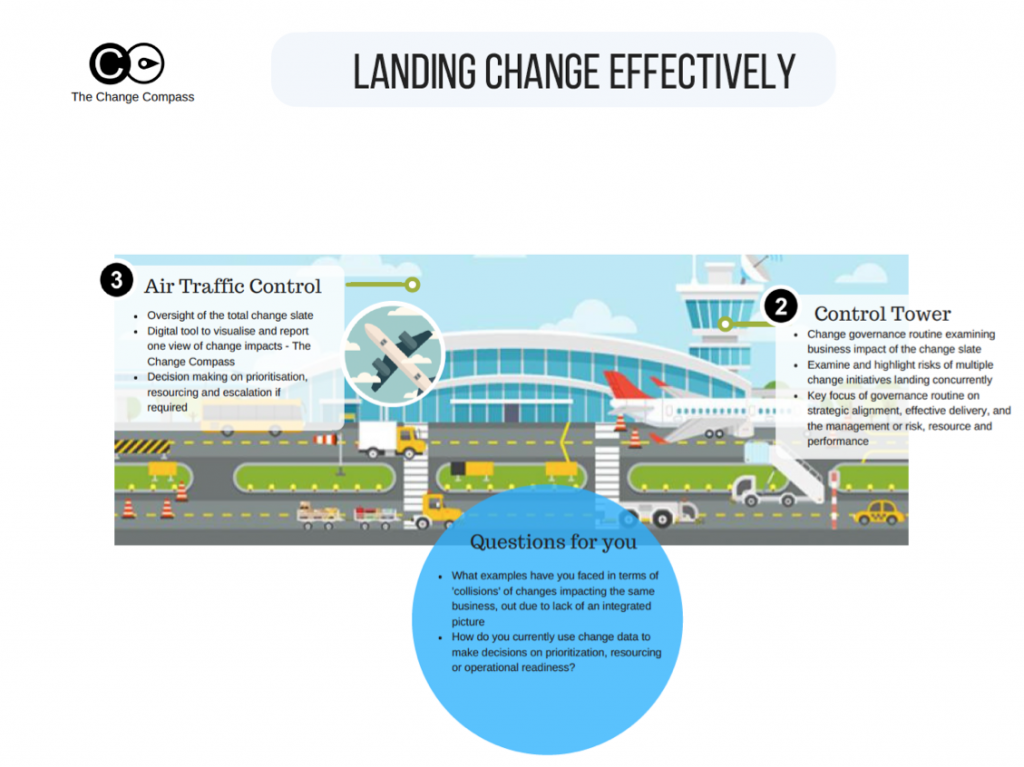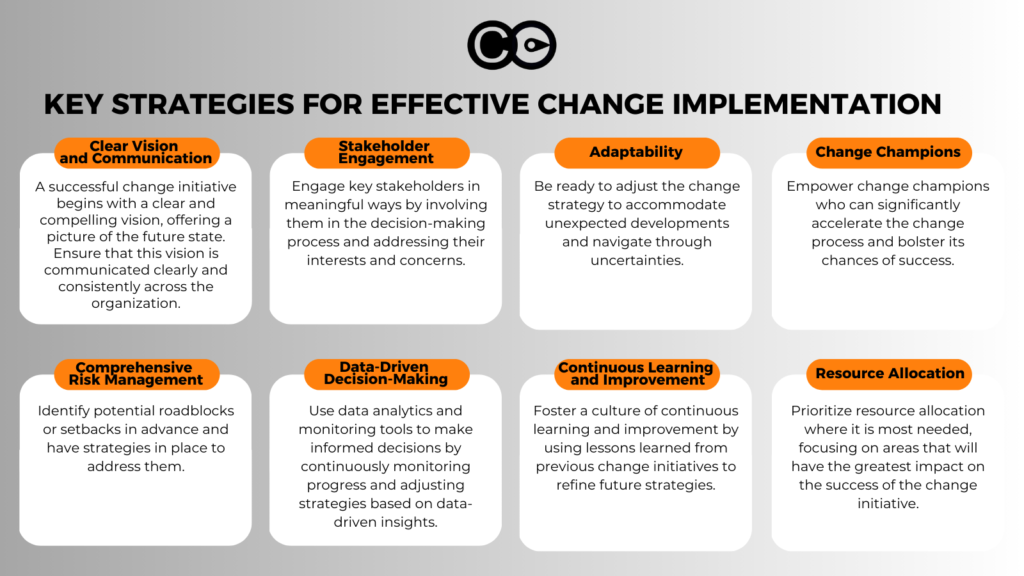
Infographic: Landing multiple changes in a complex environment. The role of Control Tower and Air Traffic Control
Infographic: Landing multiple changes in a complex environment. The role of Control Tower and Air Traffic Control




Adapting to change has always been a formidable challenge for organizations, but the complexities of today’s business landscape have taken this challenge to a new level. With the relentless march of technological advancements, the dynamic shifts in market dynamics, and the constant evolution of the workforce, organizations find themselves in a perpetual state of transformation. Effectively navigating these changes within an intricate and multifaceted environment is no longer a choice but a necessity. In this era of constant flux, mastering the art of change implementation within complex contexts has become a critical skill for organizations seeking not only survival but also prosperity.
This article is dedicated to unraveling the intricacies of change management within such complex settings, providing a comprehensive exploration of the strategies and considerations that can illuminate the path to successful change implementation.

Complex environments, as depicted by the infographic, resemble a bustling traffic control center overseeing a multitude of ongoing changes. These environments typically feature intricate organizational structures with various departments, multiple stakeholder interests, regulatory requirements, and external factors like economic conditions, global trends, and competition—all converging and coexisting like different lanes of traffic.
Just as a traffic control center needs a comprehensive view to manage traffic effectively, organizations must also have a holistic understanding of their unique complexities to facilitate change management. The infographic highlights the importance of having a tool like, “The Change Compass,” to visualize and report one view of change impacts, much like the control tower in our analogy. “The Change Compass” aids in decision-making regarding prioritization, resourcing, and escalations when required, ensuring smoother change implementation.
Much like a control tower’s routine examination of air traffic, change governance routines within complex environments need to scrutinize the business impact of the change slate. They should examine and highlight potential risks when multiple change initiatives land concurrently. The key focus of governance routines should revolve around maintaining strategic alignment, ensuring effective delivery, and managing risks, resources, and performance effectively.
In the context of the infographic and your real-world experience, it’s important to consider situations where changes collide due to a lack of an integrated picture. Understanding these scenarios and their consequences can further emphasize the importance of a comprehensive view, akin to what “The Change Compass” offers.
Additionally, the infographic raises questions about the utilization of change data for decision-making. As you review these questions, it’s essential to reflect on your organization’s practices and how it currently employs change data to prioritize initiatives, allocate resources, and assess operational readiness.
By aligning these insights from the infographic with your practical experiences, you can gain a deeper appreciation of the nuances and challenges within complex environments and the strategies required for effective change management.
Clear Vision and Communication: Imagine a ship embarking on a complex voyage. In this analogy, a well-articulated vision serves as the North Star, guiding the crew toward their desired destination. A successful change initiative begins with a clear and compelling vision, offering a picture of the future state. Within complex environments, the importance of this vision is magnified. It’s vital that this vision is not just communicated but ingrained, clear, and consistent across the organization. Complex environments often require tailored communication strategies, akin to setting multiple navigation markers, to reach diverse stakeholder groups effectively. From employees to executives, everyone on the ship should have a deep understanding of the change’s purpose and the benefits it will bring.
Stakeholder Engagement: Complex environments can be likened to a bustling marketplace where diverse customers with unique tastes gather. Managing change within such settings requires recognizing and respecting these differences. Just as merchants engage in open dialogue with customers to understand their preferences, organizations must engage key stakeholders in meaningful ways. This includes involving them in the decision-making process and addressing their interests and concerns. By aligning the organization’s objectives with the diverse needs of these stakeholders, you ensure a smoother journey toward successful change implementation.
Adaptability: Picture change within complex environments as a voyage with unpredictable weather. The ability to adapt is the organization’s agility in navigating through choppy waters. Change within these environments is rarely a straightforward path; it often demands adaptability and the willingness to adjust course based on emerging challenges or unforeseen opportunities. Like skilled sailors, leaders and change agents must be open to feedback, agile in their decision-making, and ready to adjust the change strategy to accommodate unexpected developments. Flexibility is the key when facing the uncertainties inherent in complex settings.
Change Champions: Think of change champions as the seasoned navigators of the ship. These individuals are passionate advocates for change, influential within the organization, and adept at mentoring and supporting others in adopting new ways of working. Empowering these champions is akin to putting experienced navigators at the helm; it significantly accelerates the change process and bolsters its chances of success.
Comprehensive Risk Management: Complex environments can be compared to a terrain filled with potential obstacles and surprises. To navigate these challenges successfully, organizations must conduct a thorough risk assessment, much like charting the unknown waters ahead. It is essential to develop robust risk mitigation plans that identify potential roadblocks or setbacks in advance and have strategies in place to address them. Risk management should be an ongoing process throughout the change journey, just as a vigilant captain keeps a watchful eye on the horizon.
Data-Driven Decision-Making: Envision data as a compass that guides the ship through uncharted waters. Leveraging data analytics and monitoring tools can provide valuable insights into the impact of the change. Like a captain relying on navigation instruments, organizations can make informed decisions by continuously monitoring progress and adjusting strategies based on data-driven insights. This ensures that the ship stays on the right course and is ready to make course corrections as needed.
Continuous Learning and Improvement: Consider change implementation as a perpetual voyage of discovery. Organizations should foster a culture of continuous learning and improvement, much like a ship’s log recording its journey. Lessons learned from previous change initiatives should be used to refine future strategies and enhance the organization’s change management capabilities. A feedback loop, encouraging crew members to share their experiences and insights, can be instrumental in this process, much like sailors sharing their knowledge to improve the voyage.
Resource Allocation: Resource allocation can be compared to provisioning the ship for a long journey. Efficient allocation of resources is critical, especially in resource-constrained complex environments. Organizations must prioritize resource allocation where it is most needed, focusing on areas that will have the greatest impact on the success of the change initiative. This may involve reallocating human resources, budget, or other assets to support the change effort. Resource allocation decisions should be informed by a clear understanding of the change’s objectives and the unique challenges posed by the complex environment, much like carefully planning and managing supplies for the voyage.
These strategies form the compass and toolkit for organizations seeking to navigate the complex seas of change. Just as a skilled captain combines experience, navigation tools, and a committed crew to chart a successful course, organizations can achieve effective change implementation by integrating these strategies into their change management process.

Effectively landing change within a complex environment is a multifaceted and challenging process. However, it is not without its rewards. With a clear vision, robust communication, stakeholder engagement, adaptability, data-driven decision-making, a commitment to continuous improvement, and a strategic approach to resource allocation, organizations can successfully navigate the complexities of change implementation.
In a world where change is the new constant, mastering the art of change within complex environments is not only a valuable skill but a competitive advantage. By doing so, organizations can emerge stronger, more agile, and better prepared to face the dynamic challenges of today’s business world.
The ability to implement change within complex environments is a key differentiator that sets organizations on a path to resilience and long-term success. To take the first step in mastering the art of change within complexity, we invite you to book a weekly demo with “The Change Compass.” Discover how our innovative digital tool can be your trusted guide in navigating change within complex environments. Embrace the challenges, and unlock the opportunities that lie ahead in the ever-evolving landscape of business transformation.

Right now I am writing this article from a Four Seasons resort in Hawaii after having 3 flights cancelled in a row. It has been quite a stressful experience as you can imagine and it’s the fourth day of delay. I’m not able to get back home! However, this started to get me thinking about the change experience for the employee or the customer. As change drivers or leaders we tend to focus on how to design the change at a program level and it’s rare for us to really get down to the lowest level of people experience and how this is perceived at a humanistic level throughout the change process.
In the past I’ve used the airport analogy to describe the change journey and how we work to design each of the elements of the whole ecosystem, including pre-departure, transit, in-flight experience, runway preparation and post-landing experience. To read more about each of these elements refer to this article on Landing multiple changes in a complex environment.
Now let’s take a look at my recent bad flight experience and you will see that this easily translates to a typical change experience for those impacted. My first flight was cancelled, and after several hours all passengers were feeling frustrated, wondering what was really going on, and when or if the flight will take off. The announcement did not provide any substantive information and so as a result each passenger had to queue up to ask for further information. This is similar to a restructuring announcement or other major changes whereby there is a generic corporate email sent to all impacted, however the information is so generic that employees will need to resort to their managers (or rumours) to get further information that will meet their individual needs.
For the managers, they often don’t receive the right information or it is insufficiently tailored so that they are not able to translate the organisational level impact to how their specific department or team will be impacted. This could be due to lack of information or skill set in translating the impact for their teams. To this end, we need to ensure we engage with those managers to ensure that their questions are answered and that they’re able to field employe questions, versus having no information.
Part of a good change experience is in anticipating any reactions, feelings and designing an effective process that tackles these head on. To do this, use a human-centred design approach of observation, interviewing, analysing precious incidents and basically adopt a human-centred mindset to pick out key experience insights that need to be addressed. To read more about the human-centred design process please click here.
So what can we learn from the bad pre-departure experience when applied to change?
1. Provide managers and leader with sufficient information so that they are able to engage with and consult with their impacted employees to ensure that their needs are met
2. Conduct a detailed analysis from an end-user perspective to pre-determine potential humanistic needs and reactions and address these head-on. For example, What types of information are needed? What are potential employee questions? How do we provide them with effective engagement prior to them asking for it?
3. Proactive engagement to manage potentially negative feelings. Being on the receiving end of a flight cancellation or change initiative is often frustrating and stressful. How do we anticipate these experiences to redesign it into a more positive one? For example, are there certain employee groups we can garner to be change champions to provide additional people support? What artefacts can we provide to shape these experiences? Visually-catching cheat sheets, posters, branded sweets, morning-tea, etc.
4. Involve all layers of management so that they are well-equipped to support the change and are clear with their role in the process. Are we simply asking them to be on-hand to answer questions? Or do we expect certain layers of management to be change coaches to guide first-line managers on how to lead change. What are we asking our Human Resources colleagues to be doing? Or our Risk partners or Finance partners? Be explicit about what specific behaviours and outcomes we are asking for.
5. Empathy. When people are frustrated, feeling vulnerable or stressed, the most important thing to do to address their feelings is to acknowledge and address these feelings by showing empathy. After all we are dealing with people’s emotions. Emotions are not logical and therefore data and facts usually do not create empathy. Empathy is between two individuals. One person showing another person that their feelings are valid, acknowledged and supported. Empathy is best demonstrated through verbal or nonverbal behaviours rather than through emails and online information. This is about a leader or another colleague showing genuine acknowledgement that a fellow colleague feels a certain way, without providing any judgment or even advice. During one of the days when the flight was cancelled, a staff walked around and chatted to everyone in the queue to just listen to them and acknowledge their frustrations – this did more good than anything else the airline did.
6. Create an element of surprise in designing the change process. Most corporate change processes are similar in that they follow a set way of engaging with employees according to the corporate norm of what has worked in the past. However, there are some organizations that keep follow norms and do not create a good change experience and keep repeating the same mistakes. I’m sure we have all experience this J. For example, it could a senior leader walking the floor to connect with impacted employees during the change process, or corporate artefacts that were not anticipated and could be perceived in a positive light.
7. Appealing to the senses. A lot of people remember sensory information more than data or facts. How do we leverage this to create the overall experience? Retail stores often dispense aromatherapy scents to create and environment or calm or excitement depending on the desired experience. Visual information is also important to create the right imagery so that employees can visualise the light at the end of the tunnel and be inspired to go through the tunnel. One can design visual images that help employee remember themes, or analogies that are easily understood and visualised (and therefore easily memorised).
My experience with The Four Seasons hotel from when I entered the hotel through to using its various amenities is that there is significant care and detailed anticipation of user needs. From personal interactions with staff that show care and rapport, through to facilities that are carefully designed to incorporate guest needs. For me the surprise element was the room iPad greeting me with my name and giving me a run down of the weather, things to do and other location and hotel references. The challenge for us as change leaders is to learn from this and think through how we design great change experience that are out of the ordinary and far from the typical ho-hum corporate approaches in initiative roll out.
Share this post with your contacts.